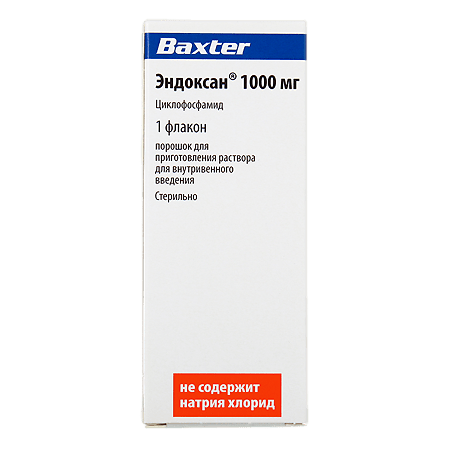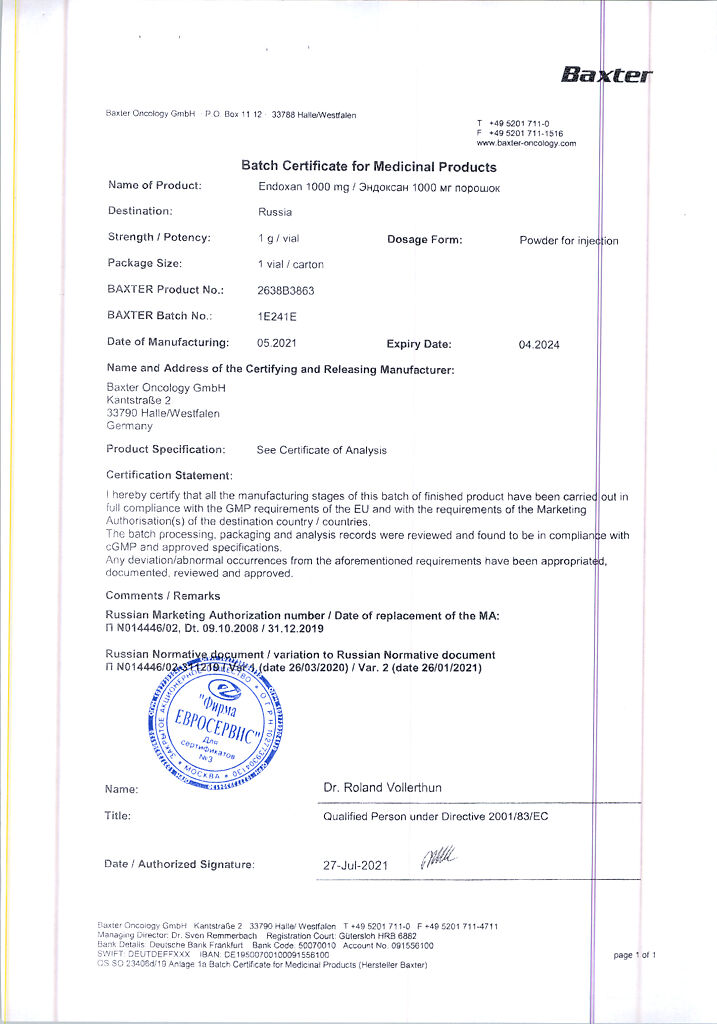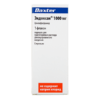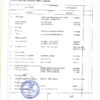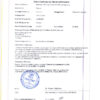No products in the cart.
Description
Framacodynamics
Cyclophosphamide is an alkylating cytostatic drug chemically similar to nitrogen analogues of mustard gas.
The mechanism of action is thought to involve the formation of cross-links between DNA and RNA strands as well as inhibition of protein synthesis.
Pharmacokinetics
The drug content in blood after IV and oral administration is the same. It is metabolized mainly in liver under action of microsomal oxidase system, forming active alkylating metabolites (4-OH cyclophosphamide and aldophosphamide), part of which undergo further transformation to inactive metabolites, another part is transported into cells, where under action of phosphatases they transform into cytotoxic metabolites. Cmax of metabolites reaches in plasma 2-3 hours after injection.
The binding of unchanged drug with plasma proteins is low (12-14%), but some metabolites bind more than 60%. There is limited penetration through the HEB.
Cyclophosphamide is excreted by the kidneys mainly as metabolites, but 5-25% of the administered dose is excreted unchanged in the urine, as well as in the bile. T1/2 is 7 hours for adults and 4 hours for children.
Indications
Indications
Active ingredient
Active ingredient
Composition
Composition
1 vial contains:
Active ingredients:
Cyclophosphamide monohydrate 1069 mg, which corresponds to a cyclophosphamide content of 1000 mg.
In a bottle of 75 ml.
There is 1 vial in the carton pack
How to take, the dosage
How to take, the dosage
Endoxan is part of many chemotherapeutic treatment regimens; therefore, the dosing regimen should be guided by the data in the literature when choosing a dosing regimen for each individual case.
The most commonly used doses and regimens for adults and children when administered parenterally:
If the drug is used in combination with other antitumor drugs, a reduction in the dose of both Endoxan and other drugs may be required.
Before intravenous administration the drug is dissolved in water for injection or 0.9% sodium chloride solution to a concentration of 20 mg/ml.
Interaction
Interaction
Microsomal oxidation inducers in the liver can induce microsomal metabolism of cyclophosphamide, which leads to increased formation of allylic metabolites, thereby reducing the elimination half-life of cyclophosphamide and increasing its activity.
The use of cyclophosphamide, which causes marked and prolonged inhibition of cholinesterase activity, enhances the effects of suxamethonium and also reduces or slows cocaine metabolism, thereby increasing and/or extending the duration of its effects and increasing the risk of toxic effects.
Concomitant use with allopurinol may also increase the toxic effects on bone marrow.
In concomitant use of cyclophosphamide, allopurinol, colchicine, probenecid, sulfinpyrazone doses of antipodagric agents may need to be adjusted. The use of uricosuric antipodagric agents may increase the risk of nephropathy associated with increased uric acid formation when using cyclophosphamide.
Cyclophosphamide may increase anticoagulant activity as a result of decreased hepatic synthesis of clotting factors and impaired platelet formation, but may also decrease anticoagulant activity through an unknown mechanism.
Because grapefruit contains a compound that can interfere with cyclophosphamide activation and thereby its effects, patients should not eat grapefruit or drink grapefruit juice.
Cyclophosphamide increases the cardiotoxic effects of doxorubicin and daunorubicin.
Other immunosuppressants (azathioprine, chlorambucil, GCS, cyclosporine, mercaptopurine) increase the risk of infections and secondary tumors.
The concomitant use of lovastatin in patients undergoing heart transplantation may increase the risk of acute skeletal muscle necrosis and acute renal failure.
Drugs causing myelosuppression, as well as radiation therapy – additive suppression of bone marrow function is possible.
The concomitant use of high-dose cytarabine with cyclophosphamide in preparation for bone marrow transplantation resulted in an increased incidence of cardiomyopathy with subsequent death.
Special Instructions
Special Instructions
During treatment with the drug, regular blood tests should be performed (especially paying attention to the neutrophil and platelet counts) to assess the degree of myelosuppression, and regular urine tests for the presence of erythrocytes, the appearance of which may precede the development of hemorrhagic cystitis.
In case of signs of cystitis with micro- or macrohematuria, treatment with Endoxan should be discontinued.
In case of decrease of leukocyte count to 2500/μl and/or platelets to 100 000/μl, treatment with Endoxan should be discontinued.
In case of infections during Endoxan therapy, treatment should either be interrupted or the dose of the drug should be reduced.
When high doses of Endoxan are used, Mesna is prescribed to prevent the development of hemorrhagic cystitis.
During treatment, alcoholic beverages should be refrained.
If Endoxan is prescribed within the first 10 days after surgery performed under general anesthesia, the anesthesiologist must be informed.
After an adrenalectomy, the patient needs a dose adjustment of both the GCS used for replacement therapy and Endoxan.
Women and men should use reliable methods of contraception during treatment with Endoxan.
Contraindications
Contraindications
With caution: in severe diseases of the heart, liver and kidneys, adrenalectomy, gout (history), nephrourolithiasis, suppression of bone marrow function, bone marrow infiltration by tumor cells, prior radiation or chemotherapy.
Side effects
Side effects
Blood system: leukopenia, neutropenia; rarely – thrombocytopenia, anemia. The greatest decrease in the number of leukocytes and platelets is usually observed on days 7-14 of treatment. Recovery of blood parameters with leukopenia usually begins 7-10 days after discontinuation of treatment.
Digestive system disorders: nausea, vomiting, anorexia, less often stomatitis, discomfort or pain in the abdominal area, diarrhea or constipation. There are some reports of hemorrhagic colitis and jaundice.
Rare cases of liver dysfunction have been reported, manifested by increased liver transaminase activity, alkaline phosphatase level and serum bilirubin content. In 15-50% of patients receiving high doses of cyclophosphamide in combination with busulfan and total irradiation during allogeneic bone marrow transplantation, hepatic vein obliterative endophlebitis develops. A similar reaction in very rare cases is also seen in patients receiving high doses of cyclophosphamide alone in patients with aplastic anemia. This syndrome usually develops 1-3 weeks after bone marrow transplantation and is characterized by a dramatic increase in body weight, hepatomegaly, ascites, and hyperbilirubinemia. Hepatic encephalopathy may also be observed.
Skin and skin appendages: alopecia often develops. Hair regrowth begins after completion of treatment with the drug or even during prolonged treatment; hair may vary in structure and color. Sometimes during treatment, a skin rash appears, skin pigmentation and nail changes are observed.
Urinary system disorders: hemorrhagic urethritis, cystitis, renal tubule necrosis. In rare cases this condition may be severe and even fatal. Bladder fibrosis may also develop, sometimes widespread, with or without cystitis. Atypical bladder epithelial cells may be found in the urine. These side effects depend on the dose of Endoxan and the duration of treatment. Prevention of cystitis is aided by hydration and the use of mesna. Usually in severe forms of hemorrhagic cystitis, treatment with the drug should be discontinued. When high doses of cyclophosphamide are prescribed in rare cases, renal dysfunction, hyperuricemia, nephropathy associated with increased uric acid formation may be observed.
Infections: serious infections may develop in patients with severe forms of immunosuppression.
Cardiovascular system: Cardiotoxicity has been observed when high doses of 4.5-10 g/m2 (120 to 270 mg/kg) of the drug are administered for several days, usually as part of intensive combined antitumor or drug therapy in organ transplantation. Severe and sometimes fatal episodes of congestive heart failure due to hemorrhagic myocarditis have been reported.
Respiratory system: interstitial pulmonary fibrosis (when administering high doses of the drug for a long time).
Reproductive system disorders: disruption of oogenesis and spermatogenesis. The drug may cause sterility in both men and women, which in some cases may be irreversible.
A large proportion of women develop amenorrhea; regular menstruation usually recovers within a few months of stopping treatment. In girls treated with cyclophosphamide during the prepubertal period, secondary sexual characteristics developed normally and menstruation was normal; they were subsequently able to conceive.
Males may develop oligospermia or azoospermia as a result of treatment with the drug, due to increased gonadotropin levels with normal testosterone secretion. Sexual desire and potency in such patients are not impaired. In boys, during treatment with the drug in the prepubertal period, secondary sexual characteristics develop normally, however, oligospermia or azoospermia and increased gonadotropin secretion may be noted. Testicular atrophy of varying degrees may be noted. In some patients azoospermia caused by the drug is reversible, but recovery of impaired function may not occur until several years after discontinuation of treatment.
Carcinogenicity: Some patients who were previously treated with the drug in monotherapy or in combination with other anticancer drugs and/or other treatments developed secondary malignant tumors. Most often these were bladder tumors (usually in patients with previous hemorrhagic cystitis), myeloproliferative or lymphoproliferative diseases. Secondary tumors most often developed in patients as a result of treatment of primary myeloproliferative malignancies or non-malignant diseases, with immune disorders. In a number of cases a secondary tumor developed several years after discontinuation of treatment with the drug.
When evaluating the relationship between expected benefits and possible risks of a drug, always keep in mind the potential for malignancy induction by the drug.
Allergic reactions: skin rash, urticaria, or itching; rarely, anaphylactic reactions.
Other: one case of possible cross-sensitivity with other alkylating agents has been described. Cyclophosphamide may interfere with normal wound healing. A syndrome similar to inadequate ADH secretion syndrome may develop. Redness, swelling, or pain at the injection site. Blood rush to the face or reddening of the face, headache, increased sweating.
Overdose
Overdose
A specific antidote for drug overdose is unknown.
In cases of overdose, supportive measures should be used, including appropriate treatment for infections, manifestations of myelosuppression or cardiotoxicity.
Pregnancy use
Pregnancy use
The drug is contraindicated in pregnancy and during lactation.
The drug may cause sterility in both men and women, which in some cases may be irreversible.
A large proportion of women develop amenorrhea, with regular menstruation usually recovering within a few months of stopping treatment. In girls treated with cyclophosphamide during the prepubertal period, secondary sexual characteristics developed normally and menstruation was normal; they were subsequently able to conceive.
Males may develop oligospermia or azoospermia as a result of treatment with the drug, due to elevated gonadotropin levels with normal testosterone secretion.
The libido and potency in such patients are not impaired. In boys, during treatment with the drug in prepubertal period, secondary sexual signs develop normally, however, oligospermia or azoospermia and increased gonadotropin secretion may be noted. Testicular atrophy of varying degrees may be noted.
In some patients azoospermia caused by the drug is reversible, but recovery of impaired function may not occur until several years after discontinuation of treatment.
Additional information
| Weight | 0.010 kg |
|---|---|
| Shelf life | 3 years. |
| Conditions of storage | Store at a temperature not exceeding 25 ° C out of the reach of children. |
| Manufacturer | Baxter Oncology GmbH, Germany |
| Medication form | Powder for preparation of solution |
| Brand | Baxter Oncology GmbH |
Related products
Buy Endoxan, 1 g with delivery to USA, UK, Europe and over 120 other countries.

